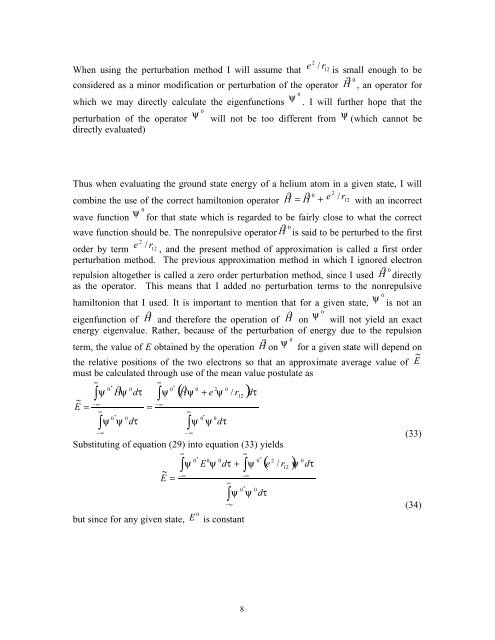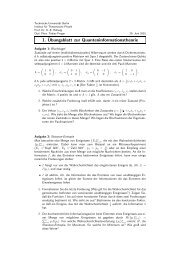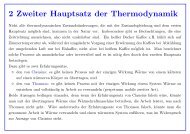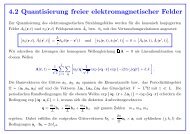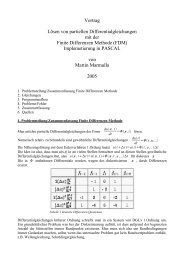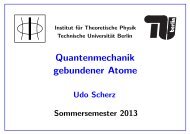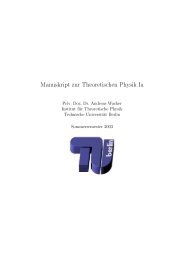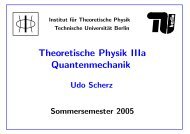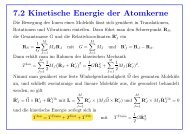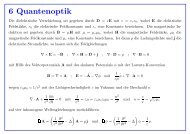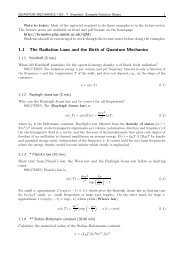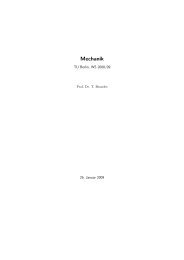INTRODUCTION I have decided to do a project on how to ...
INTRODUCTION I have decided to do a project on how to ...
INTRODUCTION I have decided to do a project on how to ...
- No tags were found...
You also want an ePaper? Increase the reach of your titles
YUMPU automatically turns print PDFs into web optimized ePapers that Google loves.
When using the perturbati<strong>on</strong> method I will assume thate 2 / r12is small enough <str<strong>on</strong>g>to</str<strong>on</strong>g> bec<strong>on</strong>sidered as a minor modificati<strong>on</strong> or perturbati<strong>on</strong> of the opera<str<strong>on</strong>g>to</str<strong>on</strong>g>r0 ?H , an opera<str<strong>on</strong>g>to</str<strong>on</strong>g>r forwhich we may directly calculate the eigenfuncti<strong>on</strong>s0ψ . I will further hope that theperturbati<strong>on</strong> of the opera<str<strong>on</strong>g>to</str<strong>on</strong>g>r0ψ will not be <str<strong>on</strong>g>to</str<strong>on</strong>g>o different from ψ (which cannot bedirectly evaluated)Thus when evaluating the ground state energy of a helium a<str<strong>on</strong>g>to</str<strong>on</strong>g>m in a given state, I willcombine the use of the correct hamil<str<strong>on</strong>g>to</str<strong>on</strong>g>ni<strong>on</strong> opera<str<strong>on</strong>g>to</str<strong>on</strong>g>r H ? = H ? 0+ e 2 / r12with an incorrect0wave functi<strong>on</strong>ψ for that state which is regarded <str<strong>on</strong>g>to</str<strong>on</strong>g> be fairly close <str<strong>on</strong>g>to</str<strong>on</strong>g> what the correct0wave functi<strong>on</strong> should be. The n<strong>on</strong>repulsive opera<str<strong>on</strong>g>to</str<strong>on</strong>g>r?H is said <str<strong>on</strong>g>to</str<strong>on</strong>g> be perturbed <str<strong>on</strong>g>to</str<strong>on</strong>g> the firs<str<strong>on</strong>g>to</str<strong>on</strong>g>rder by terme 2 / r12, and the present method of approximati<strong>on</strong> is called a first orderperturbati<strong>on</strong> method. The previous approximati<strong>on</strong> method in which I ignored electr<strong>on</strong>0repulsi<strong>on</strong> al<str<strong>on</strong>g>to</str<strong>on</strong>g>gether is called a zero order perturbati<strong>on</strong> method, since I used?H directlyas the opera<str<strong>on</strong>g>to</str<strong>on</strong>g>r. This means that I added no perturbati<strong>on</strong> terms <str<strong>on</strong>g>to</str<strong>on</strong>g> the n<strong>on</strong>repulsive0hamil<str<strong>on</strong>g>to</str<strong>on</strong>g>ni<strong>on</strong> that I used. It is important <str<strong>on</strong>g>to</str<strong>on</strong>g> menti<strong>on</strong> that for a given state,ψ is not aneigenfuncti<strong>on</strong> of H ? and therefore the operati<strong>on</strong> of H ? 0<strong>on</strong>ψ will not yield an exactenergy eigenvalue. Rather, because of the perturbati<strong>on</strong> of energy due <str<strong>on</strong>g>to</str<strong>on</strong>g> the repulsi<strong>on</strong>term, the value of E obtained by the operati<strong>on</strong> H ? 0<strong>on</strong>ψ for a given state will depend <strong>on</strong>the relative positi<strong>on</strong>s of the two electr<strong>on</strong>s so that an approximate average value of E ~must be calculated through use of the mean value postulate as~E =∞∫ψ−∞∞∫− ∞*0ψH?ψ*0ψ00dτdτ=∞∫− ∞ψ*0( H?0 2 0ψ + e ψ / r )∞∫− ∞ψ*0ψ0dτ12dτSubstituting of equati<strong>on</strong> (29) in<str<strong>on</strong>g>to</str<strong>on</strong>g> equati<strong>on</strong> (33) yields~E =∞∫−∞but since for any given state,ψ*00E ψ0dτ+∞∫−∞ψ∞∫−∞*00E is c<strong>on</strong>stantψψ*002( e / r )dτ12ψ0dτ(33)(34)8


